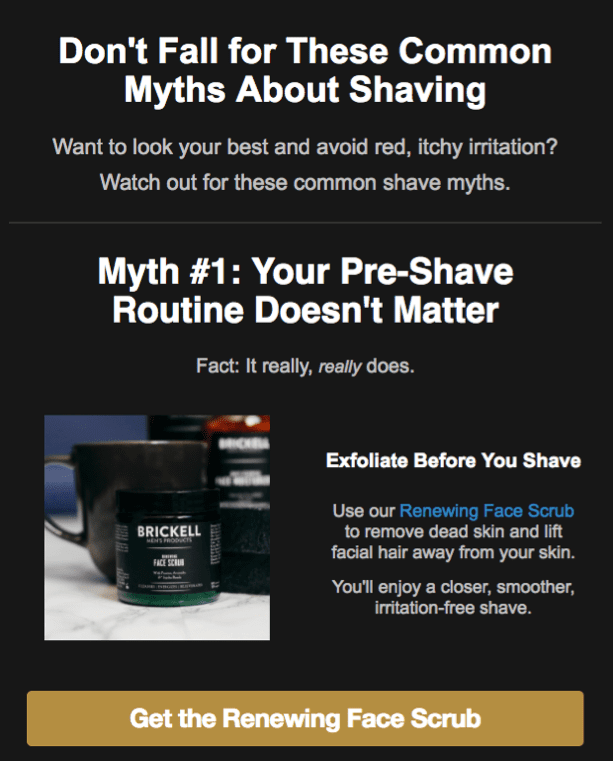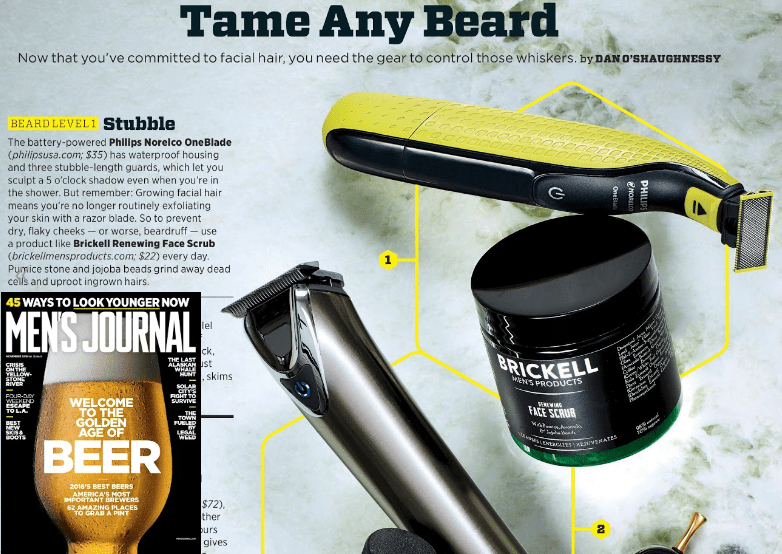Finding creative ways to market a product that isn’t going to get millions of social shares
Going viral. It’s the dream of so many digital marketers. If you could just get one video, one blog post, one social media infographic to go viral. Then your campaign (or product or client) would be a total success.
But what can you do when going viral isn’t an option? How can you use digital marketing techniques to successfully reach an audience that needs your product, but might not be willing to admit it on their social networks?
It’s a challenge, but it can be done. And with great success. Take one example: Brickell Men’s Products.

This luxury men’s skincare brand was started with a heavy dose of reality. The story of the company’s founding starts with Josh - one of the co-founders - being teased by his girlfriend because he was starting to show wrinkles, especially around his eyes. That’s how he realized that guys just like him - young professionals - are actually worried about skincare.
But he also knew they weren’t going to be complaining about wrinkles, sharing skincare secrets, or raving about their moisturizers and eye creams on social media.
Here are the techniques they used to go from a small operation to a multi-million dollar brand. Apply the same methods to your digital marketing approach, tweaked to the needs of your customers.
Know Your Audience
It’s the first rule of digital marketing. If you’re going to present a brand story, a marketing message, and a solution to your customers’ problem, you’ve got to know your audience.
Slip up here, and all your marketing efforts will ring false. Your tweets, posts, blogs, and emails will go ignored. And sales won’t even get off the ground floor.
Go back to the example of Brickell. They had to target their key audience: young male professionals. Here are some details they gathered:
- Who: Guys that want to keep looking young for the personal and professional benefits, but don’t want to seem vain.
- The Problem: Most men don’t really know what to do when it comes to skincare.
- The Solution: A modern skincare brand for men that is approachable and masculine – one that any man could resonate with.
These became the basis for a marketing message that has appealed to men around the world. How can you do the same with your digital marketing efforts?
Before you start preparing an email campaign or designing a landing page, think about your target audience. Ask yourself:
- How does my product solve my customers’ problem?
- What don’t my potential customers want to see when they interact with my brand?
- What unique value does my product offer for my audience?
Keep these questions ever present as you prepare your digital marketing strategy. Refer to them often. It will serve as an anchor that keeps all your marketing efforts grounded in the reality of your target audience.
Educate Your Audience
If you’re marketing a non-viral product, there aren’t a lot of resources for your industry. It may seem like a problem. But you can take that as an advantage and capitalize on it. How?
Become an expert in the area and educate your audience. Your brand will become a trustworthy source of information - leading to easier conversions and long term brand loyalty.
This is what Brickell Men’s Products has done to market their skin care products. The co-founders realized that men didn’t know much about skincare. They just knew they wanted to take better care of their appearance.
As a result, Brickell has made education a major part of their marketing strategy. You can too.
The best way is to leverage a blog. It can be your business’s main resource of education for new and returning customers – a knowledge centre.
But don’t just blog about your products and how great they are. Educate your audience. Delve into their problems and give them actionable solutions.
Brickell does this with The Grooming Manual - it’s skincare and grooming blog. Instead of touting products, it gives answers to questions men have but might not want (or know who to) ask like: Should I use female grooming products? What’s my skin type and why does it matter? Do anti-aging products really work?
Get Personal with Email Marketing
Think of your product in different terms. It’s not non-viral. It’s personal. So your marketing approach has to be personalized. And nothing’s more personal that an email straight to someone’s inbox.
If your product isn’t about to go viral, you can’t count on social media to get the word out about your brand. You have to do it yourself. The best way to do that is by building your subscriber list and emailing them regularly.
Again, the focus should be education, not just pure sales. So push your products in your email campaigns, certainly. But temper your pitches with a bit of education so the reader feels the personal benefits.
Here’s an example from a recent email campaign from Brickell Men’s Products.

Notice that the focus is on knowledge, not sales. The email’s express goal is to educate customers on shave myths.
Problem solving is what customers are looking for in your non-viral products. Make sure that is clear in all your digital marketing efforts.
Expand Your Reach with Influencer Marketing
Viral products are spread through modern day word of mouth - millions upon millions of social media shares. But if you’re selling a non-viral product - like men’s skincare products - you have to find another way to expand your reach.
Influencer marketing is the answer. But remember that there are many types of influencers. Each offers unique benefits to your business. Consider these examples:
Bloggers
Reach out to bloggers in your niche to promote and review your products. Reviews are valuable with non-viral products. Bloggers answer questions about your products that potential customers have but might not feel comfortable asking.
Print Publications
Even non-viral products can be effectively marketed via print publications, such as magazines. For example, several Brickell products have been featured in men’s magazines - like GQ, Men’s Journal, and Men’s Health. These big name influencers give social capital to your product and spread the word - even though it’s not going viral.

Other Brands
Use brands in markets adjacent to your own and leverage their reach to market your products. Here’s a great example: Brickell has been able to run contests and guest post on blogs in the men’s fashion niche. When those contests and posts go viral, it has led to new email subscribers, more blog readers, and higher sales.
Non-Viral, Hugely Successful
Are you struggling to market a non-viral product through traditional social media and blogging methods? Rethink your approach.
Focus on your audience’s needs and adapt your strategy to fulfil them. Remember that non-viral does not mean hopeless, poor performing, or unsuccessful. On the contrary - a smart approach to non-viral marketing will lead to results that are the envy of any digital marketer.

Thanks to
David Porter for sharing his advice and opinions in this post. David Porter is Marketing Director of Brickell Men’s Products. You can follow Brickell on
Twitter and
Instagram or connect with David on
LinkedIn.






 Thanks to
Thanks to 



